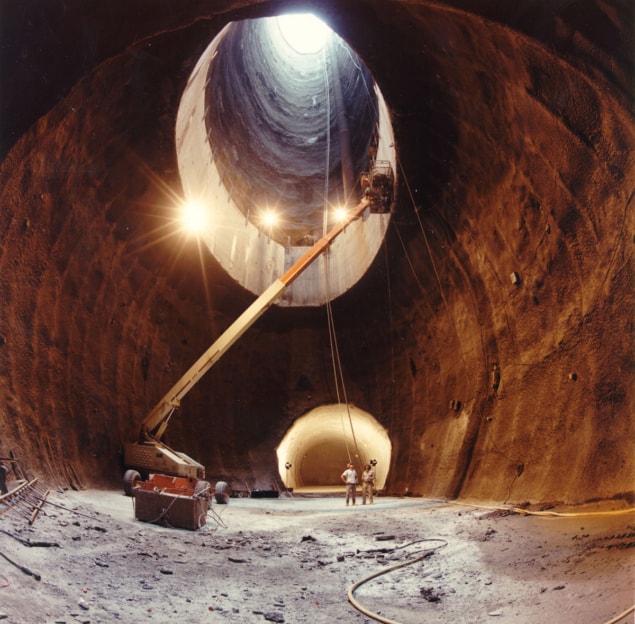Michael Riordan argues that if the US had followed a more conservative strategy when building the Superconducting Super Collider, the history of particle physics could have been different

Thirty years ago this month, the US Congress voted to terminate the Superconducting Super Collider (SSC) after some $2bn had been spent on its design and construction. At the time, nearly a third of its 87 km tunnel had already been completed, but congressional opponents insisted the SSC be “spiked” so that it could not later arise Lazarus-like from the dead. The vertical shafts from tunnel to surface (see photo) were filled as much as possible with drilling spoils, and then it was allowed to fill with groundwater.
Now, 30 years later, the world high-energy physics community is hoping to construct a comparable collider, eventually able to achieve proton–proton collisions at energies well above 15 TeV. Detailed designs exist for such colliders at CERN and in China but the all-important political will and international accord needed to proceed are increasingly rare in a splintered, deglobalizing world.
If we learned one lesson from the failure of the SSC and the success of the Large Hadron Collider (LHC), it is that broad international collaboration is mandatory at the many-TeV scale of proton collision energies. These enormous, costly projects adopted very different approaches. In the SSC case, US physicists tried to seize the leadership baton in the hope that other nations would follow, building the supercollider at a new “green-field” site in Texas.
The LHC project was instead a genuinely international effort, led by European physicists and built at CERN, a world-renowned high-energy physics laboratory – attracting contributions from Canada, India, Japan, Russia and the US. But that process occurred in the post-Cold War era, when many Eastern Bloc nations were trying to democratize and join a globalizing world economy.
The tortoise and the hare
CERN’s conservative two-phase approach to the construction of the Large Electron Positron (LEP) collider and later the LHC proved crucial. Physics research began on LEP in 1989, while the more difficult tasks of designing and fabricating the LHC’s powerful, sophisticated superconducting magnets proceeded in parallel. Consequently, CERN was able to employ the advanced “two-in-one” superconducting magnet designs that had been dropped from consideration on the SSC as (then) too immature and risky a technology.
In hindsight, such a two-phase approach would have served SSC builders much better than the road taken – of simultaneously digging an enormous tunnel and developing magnets to fill it. There would have been plenty of physics research that could have been done on an electron–positron collider in the same tunnel.
In fact, experiments on such a collider might even have discovered the Higgs boson before the turn of the century and done years of follow-up research on its behaviour while the then-onerous superconducting magnet problems were addressed and resolved.
When the SSC was being designed in the 1980s, however, few theorists thought that it would occur at a mass of merely 125 GeV. Most figured it had to show up by 1 TeV. Hence the pressing need to collide proton beams with energies of 10–20 TeV, to be certain of discovering the particle – or whatever phenomenon was responsible for elementary particle masses.
It was only after the mid-1990s discovery of the top quark at Fermilab’s Tevatron, with a mass of 175 GeV, that theorists began to recognize that such a light Higgs boson was indeed possible, if not probable. According to former CERN director-general Chris Llewellyn Smith, who led the lab from 1994 to 1998, they even thought its mass could be near 100 GeV and might be discovered at LEP.
Thus it’s unfortunate that the SSC tunnel was spiked after 1993. Building a Higgs factory there today would be relatively straightforward, requiring only completing the tunnel, installing room-temperature magnets, and constructing at least a pair of large particle detectors. It would give the high-energy physics community a viable, economical path to achieving such a facility – one that does not face the geopolitical and funding challenges as do the other two circular designs today.
And with added hindsight, a more conservative, multi-phase approach to reaching the TeV scale – as was pursued at CERN – probably would have succeeded in discovering the Higgs boson at Fermilab. For when CERN was preparing to announce its discovery in July 2012, Fermilab chimed in with a three-sigma result in the B-meson decay channel, using years-old data from what was only a 2 TeV proton–antiproton collider.

The great high-energy write-off
When a distinguished panel of scientists led by Stanford University physicist Stanley Wojcicki was assessing the future of US high-energy physics in 1983, Fermilab proposed constructing a 4–5 TeV Dedicated Collider entirely within lab boundaries. In retrospect, that would have been sufficient to discover the Higgs boson, especially if even more powerful superconducting magnets could eventually have been installed.
That approach would have kept project management in the hands of an accomplished team of accelerator physicists, instead of ceding control to engineers from the US military-industrial complex, as happened at the SSC.
The story of the LHC and the SSC is a classic example of Aesop’s famous fable, The Tortoise and the Hare. The tortoise won this race as well. But had US particle physicists pursued more conservative, cost-effective approaches to reaching the TeV energy scale – rather than trying to “leapfrog” their European colleagues with a crash, multibillion-dollar Texas project to re-establish US leadership in the field – the history of high-energy physics might have been very different.
- SEO Powered Content & PR Distribution. Get Amplified Today.
- PlatoData.Network Vertical Generative Ai. Empower Yourself. Access Here.
- PlatoAiStream. Web3 Intelligence. Knowledge Amplified. Access Here.
- PlatoESG. Carbon, CleanTech, Energy, Environment, Solar, Waste Management. Access Here.
- PlatoHealth. Biotech and Clinical Trials Intelligence. Access Here.
- Source: https://physicsworld.com/a/could-a-different-approach-have-saved-the-superconducting-super-collider/



